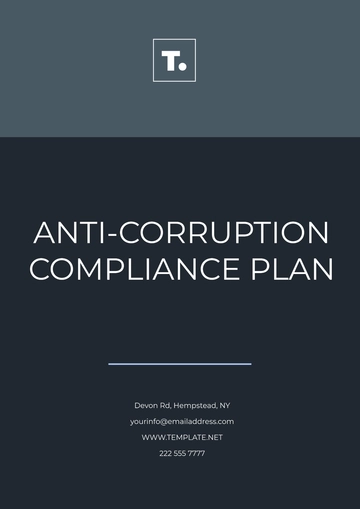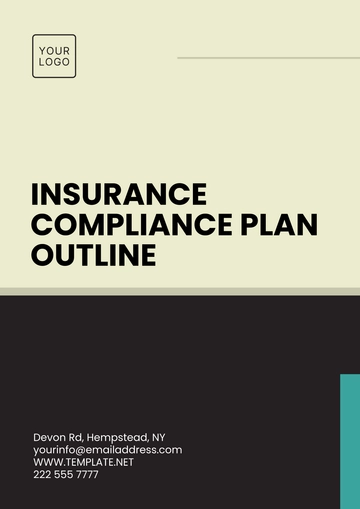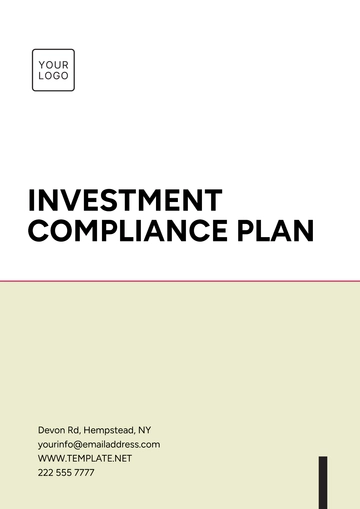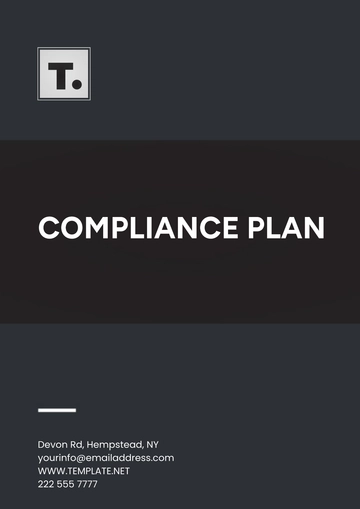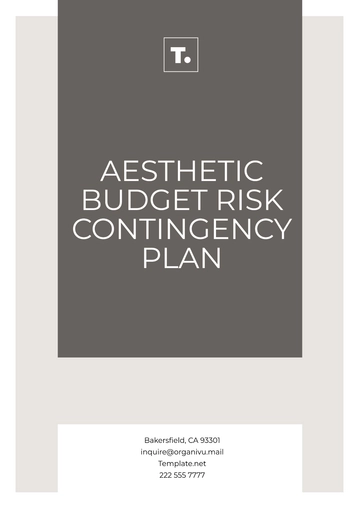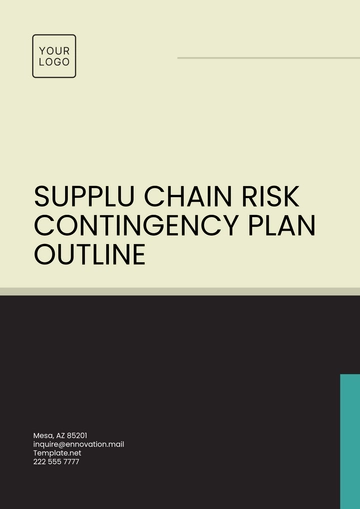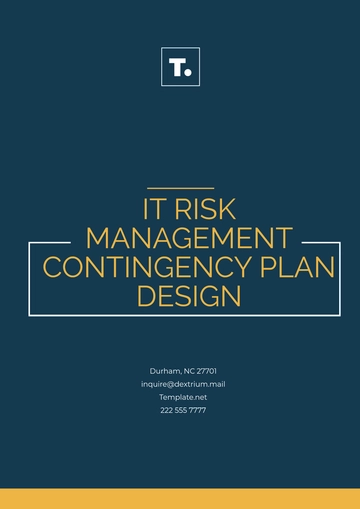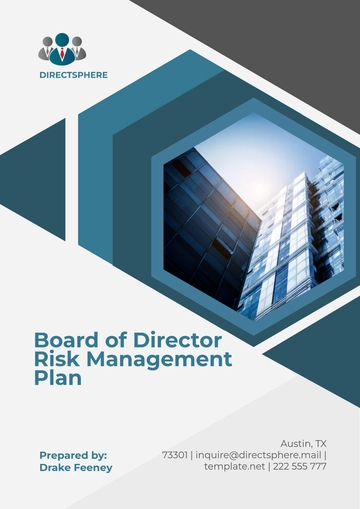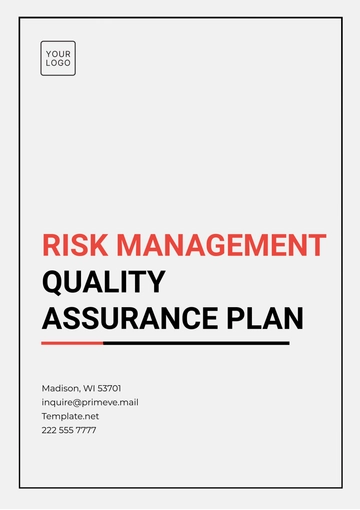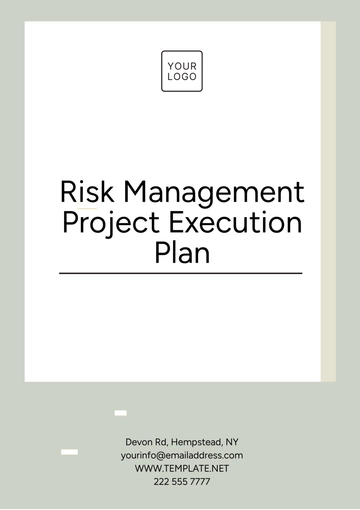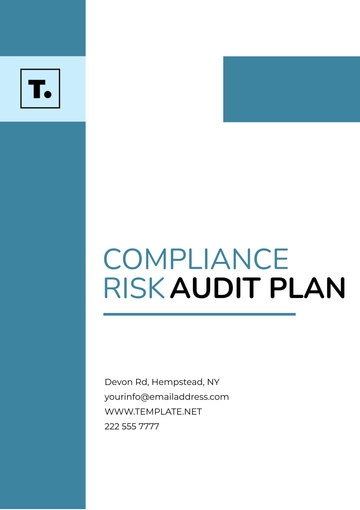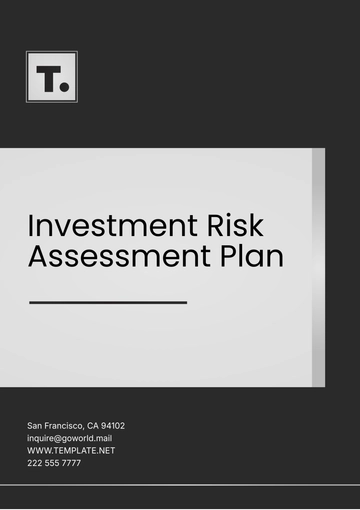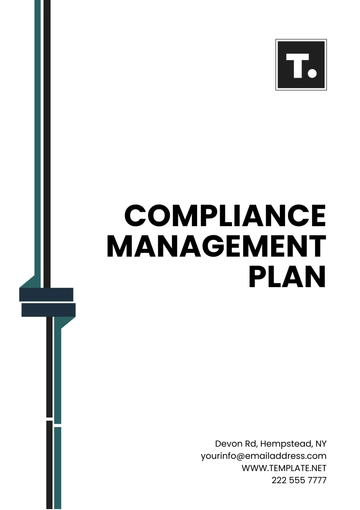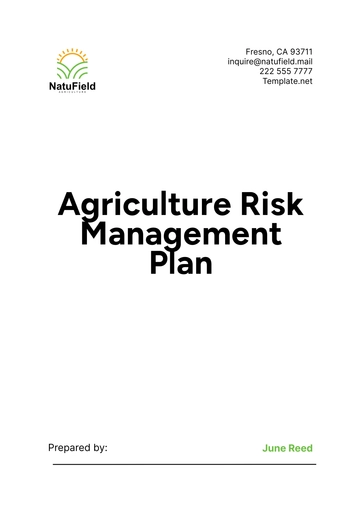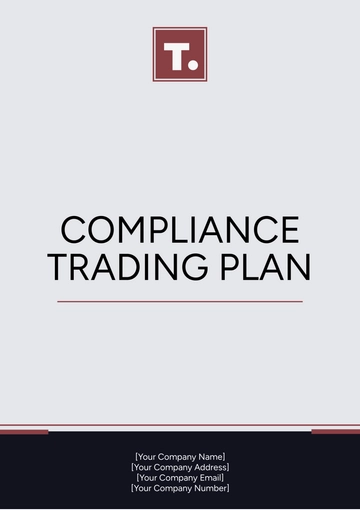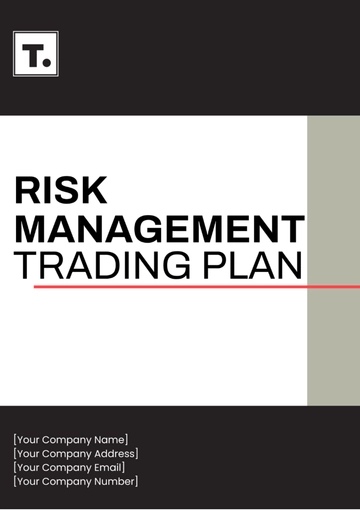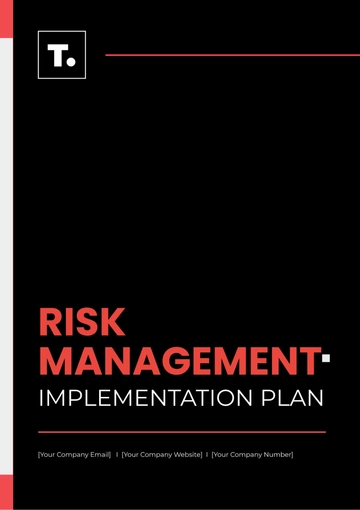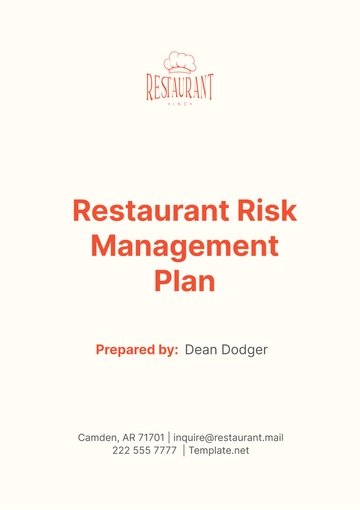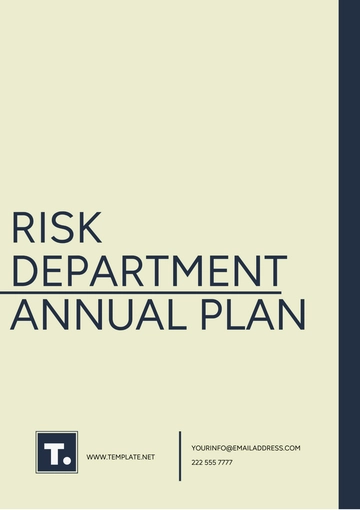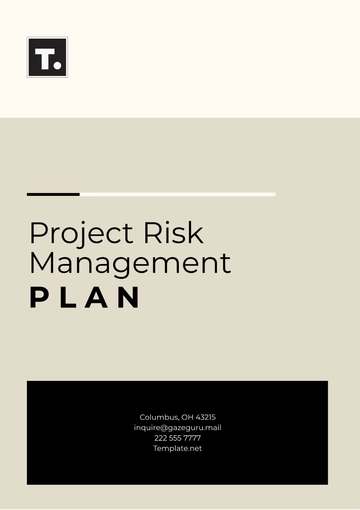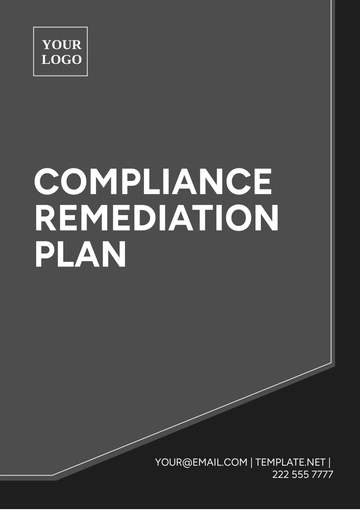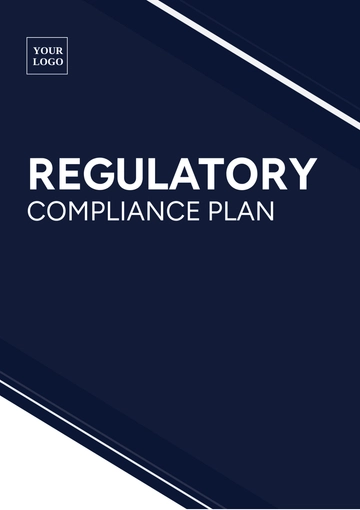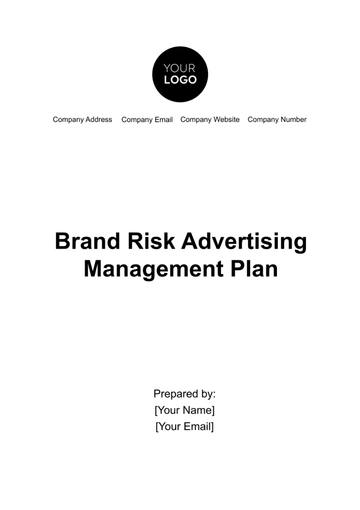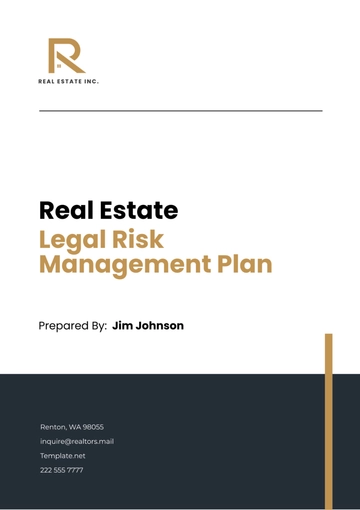Free Marketing Financial Risk Management Plan

EXECUTIVE SUMMARY
In today's fast-paced business landscape, financial stability is paramount for [Your Company Name]. This Marketing Financial Risk Management Plan serves as a robust framework for proactively identifying, assessing, and mitigating financial risks that may arise in the course of our marketing endeavors. As we navigate the ever-evolving markets and changing economic conditions, it is our unwavering commitment to not only protect our financial well-being but also to drive sustainable growth.
Our dedication to financial risk management stems from the understanding that marketing activities, while pivotal for growth, can expose us to various financial challenges. This plan outlines our strategy to effectively address these challenges, enabling us to pursue innovative marketing strategies with confidence, all while protecting our bottom line.
RISK IDENTIFICATION
In order to effectively manage financial risks associated with our marketing activities, a comprehensive identification process is essential. By recognizing potential risks, we can proactively prepare for and mitigate their impact.
RISK TYPE | DESCRIPTION |
Market Risk | Market risk encompasses a wide range of potential challenges related to the economic environment and industry fluctuations. |
Credit Risk | Credit risk pertains to the potential financial loss resulting from clients or partners failing to meet their financial obligations. |
Operational Risk | Operational risk involves the potential for financial loss due to internal processes, systems, or external factors affecting our daily operations. |
Market Risk Mitigation
To mitigate these risks, we will:
Monitor Economic and Industry Trends: Stay updated on economic conditions, industry trends, and market sentiment that may affect demand for our products or services. By being vigilant, we can anticipate market shifts and adjust our strategies accordingly.
Diversify Product Portfolio: Reducing our reliance on a single product or service can help us weather fluctuations in demand. We will explore opportunities to diversify our offerings while remaining aligned with our core competencies.
Hedging Strategies: In situations where market risks are heightened, we will explore hedging strategies, such as currency hedging or commodity price hedging, to mitigate potential financial losses.
Credit Risk Mitigation
To mitigate credit risk, we will:
Evaluate Creditworthiness: Implement a thorough credit assessment process for clients and partners. This includes reviewing their financial history, credit scores, and past payment behavior. Establishing strict criteria for creditworthiness is essential.
Establish Credit Limits and Terms: Define appropriate credit limits and payment terms for clients and partners. This ensures that we maintain control over our credit exposure and allows for timely corrective actions if credit limits are approached or breached.
Periodic Assessment: Regularly review and update the credit limits and terms based on the financial stability of clients and partners. A dynamic approach to credit management will be essential in maintaining financial stability.
Operational Risk Mitigation
To mitigate operational risks, we will:
Identify Bottlenecks: Conduct a thorough assessment of our operational processes to identify potential bottlenecks and vulnerabilities. By addressing these areas, we can minimize operational disruptions that may lead to financial losses.
Contingency Planning: Develop comprehensive contingency plans to address potential operational disruptions. These plans will detail actions to take in the event of system failures, supply chain interruptions, or other operational challenges.
Staff Training and Process Improvement: Regular staff training and continuous process improvement efforts will be undertaken to reduce the likelihood of operational errors and inefficiencies.
RISK ASSESSMENT
Probability and Impact Assessment
In this section, we assess the probability and potential impact of identified risks to provide a clear understanding of their significance to our marketing operations.
1. Market Risk Assessment:
a. Probability: We will analyze historical market data and conduct forward-looking assessments to gauge the likelihood of market fluctuations.
b. Impact: By considering the potential impact on sales, revenue, and overall profitability, we can categorize these risks into low, medium, or high impact categories.
2. Credit Risk Assessment:
a. Probability: We will establish a systematic approach for evaluating the creditworthiness of clients and partners by examining their financial history, stability, and payment track record.
b. Impact: The impact assessment will include potential financial losses in case of defaults or delayed payments, classifying credit risks based on the severity of these impacts.
3. Operational Risk Assessment:
a. Probability: To determine the likelihood of operational disruptions, we will analyze our internal processes, technology infrastructure, and human factors.
b. Impact: Impact assessment will consider the potential consequences, such as delays in marketing campaigns, reputational damage, and financial losses. Risks will be categorized based on their potential severity.
Risk Prioritization
Once we have assessed the probability and impact of each risk, we will prioritize them to focus our resources on mitigating the most significant threats to our financial stability and business continuity. Risks will be ranked in terms of their overall risk score, which considers both probability and impact ratings.
RISK MITIGATION
This section puts into detail the mitigation strategies of the identified risks and provides examples of said strategies.
Market Risk Mitigation
1. Diversify Product Portfolio: To mitigate market risk, [Your Company Name] will invest in diversifying our product or service portfolio. By offering a range of products that appeal to different customer segments or have varying demand dynamics, we can reduce our dependence on a single market niche. Diversification allows us to capture opportunities in different market segments and provides a cushion against downturns in specific markets.
Example: If your company primarily sells electronic gadgets, consider expanding your product line to include accessories, repair services, or complementary products such as cases, screen protectors, and chargers. This diversification reduces your reliance on the sales of a single product category and can help mitigate the risk associated with fluctuations in the demand for electronic gadgets.
2. Hedge Against Adverse Market Movements: In instances where we are heavily exposed to a particular market's performance, we will implement risk-hedging strategies. This may include utilizing financial instruments such as options or futures contracts to mitigate the impact of unfavorable market movements. These hedging strategies will be executed in consultation with our finance and risk management teams, and we will continuously monitor the effectiveness of these hedges.
Example: If your business relies on importing raw materials or components from overseas, you can use currency hedging strategies to protect against adverse currency exchange rate fluctuations. For instance, you might enter into forward contracts to lock in exchange rates for future transactions, ensuring that the cost of imported materials remains stable.
Credit Risk Mitigation
1. Implement Stringent Credit Checks: [Your Company Name] recognizes that extending credit to clients and partners carries inherent credit risks. To mitigate credit risk, we will implement a rigorous credit-check process for all potential clients and partners. This process will involve a thorough analysis of their credit history, financial stability, and payment behavior. By making informed decisions about whom we extend credit to, we reduce the likelihood of non-payment and related financial losses.
Example: Before extending credit to a new client or partner, conduct a thorough credit assessment. This might involve checking their credit history, financial statements, and payment behavior with other suppliers. For a B2B company, you could request financial statements, bank references, or even consider third-party credit reports to evaluate their creditworthiness.
2. Periodic Assessment of Credit Limits: We will establish and regularly reassess credit limits for clients and partners. The reassessment will be based on their financial performance, payment history, and overall creditworthiness. By periodically adjusting credit limits, we can maintain a balance between accommodating clients' needs and minimizing credit risk exposure.
Example: Suppose you extend a credit limit of $10,000 to a client initially. After a few months, you review their payment history and notice consistent, timely payments. As a result, you decide to raise their credit limit to $15,000 to accommodate their growing business needs while ensuring that they remain a low credit risk.
Operational Risk Mitigation
1. Develop Contingency Plans: [Your Company Name] is committed to reducing operational risks by proactively developing contingency plans for potential disruptions. These plans will outline strategies for responding to operational challenges, including technical failures, supply chain disruptions, and other unforeseen events. Regular drills and testing will ensure our teams are well-prepared to execute these plans when necessary.
Example: If your company relies heavily on a particular supplier for essential components, you should have a contingency plan in place. In case the supplier experiences a disruption, you can identify alternative suppliers and establish pre-negotiated contracts to ensure a continuous supply of critical components.
2. Regular Staff Training and Process Improvement: Operational risk mitigation also involves ongoing staff training and process improvement. Our employees will receive regular training on risk management procedures and best practices for mitigating operational risks. Simultaneously, we will engage in a continuous improvement process to identify and rectify operational bottlenecks, ensuring streamlined operations that minimize the likelihood of disruptions.
Example: To mitigate operational risks related to cybersecurity, you can conduct regular cybersecurity training for employees. This training might cover best practices for avoiding phishing attacks, securing sensitive data, and recognizing potential security threats. Additionally, you can continually refine your IT security protocols and systems to stay ahead of emerging cyber threats.
MONITORING AND CONTROL
Key Performance Indicators (KPIs)
Regularly tracking and assessing key performance indicators (KPIs) related to financial risk is essential to gauge the effectiveness of the risk management plan. The following KPIs will be monitored:
1. Market Risk KPIs
a. Volatility Index: Regular monitoring of market volatility indicators to preempt potential financial downturns.
b. Portfolio Diversification Ratio: Evaluating the diversification of our product portfolio and measuring its impact on risk exposure.
2. Credit Risk KPIs
a. Days Sales Outstanding (DSO): Tracking the average time taken to collect receivables from clients to ensure it remains within acceptable limits.
b. Credit Exposure vs. Available Credit: Regularly assessing the credit exposure of clients against available credit limits to avoid overexposure.
3. Operational Risk KPIs
a. Incident Response Time: Measuring the time it takes to respond to and resolve operational incidents to minimize downtime and associated financial losses.
b. Operational Efficiency Ratio: Monitoring the efficiency of our internal processes to identify areas for improvement.
Real-time Monitoring
Incorporating real-time monitoring tools and technologies is paramount to identify, assess, and respond promptly to emerging financial risks. [Your Company Name] will leverage state-of-the-art financial management software that provides real-time data and analytics. This technology will enable us to:
Receive instant alerts when financial risk thresholds are breached.
Continuously track market movements, client credit status, and operational processes.
Access real-time reporting and dashboards, allowing for swift decision-making.
By maintaining real-time oversight of key financial risk indicators, we can react swiftly and decisively, minimizing potential losses and seizing opportunities in dynamic market conditions. The real-time monitoring system will be supported by dedicated risk management personnel who will be responsible for interpreting and acting upon the data generated by these tools.
Continuous Improvement
In our commitment to effective financial risk management, [Your Company Name] recognizes the need for continuous improvement. Therefore, periodic reviews of the monitoring and control mechanisms will be conducted to assess their efficiency. Any necessary adjustments to the risk management plan, tools, or monitoring processes will be implemented to ensure we remain adaptive and resilient in the face of evolving financial challenges.
REPORTING AND COMMUNICATION
Internal Reporting
To ensure the effectiveness of our financial risk management plan, we will establish a clear system for internal reporting. This will include regular updates and status reports to be shared within our organization. These reports will provide insights into the progress of risk identification, assessment, and mitigation efforts. They will also include relevant data, analysis, and recommendations for action.
Additionally, we will set up a cross-functional team responsible for coordinating internal reporting. This team will be composed of representatives from various departments within our company, such as finance, marketing, operations, and risk management. Their role will be to ensure that the information flows smoothly between different units and that everyone is aligned with the risk management objectives.
Internal reporting will be an ongoing process, with regular meetings scheduled to discuss the latest updates, emerging risks, and adjustments to our strategies. This proactive approach will allow us to make timely decisions, adapt to changing circumstances, and continuously improve our risk management efforts.
Stakeholder Communication
Effective communication is vital to maintain transparency and trust with our stakeholders, including clients, partners, and investors. We will establish clear channels for communicating our financial risk management activities to these key parties.
Regular updates and reports will be shared with clients to inform them about our risk management practices and to address any concerns they may have. Open lines of communication will be maintained, allowing us to respond promptly to inquiries or requests for additional information.
Our partners will be kept informed about our risk management strategies and how these may impact our collaborations. We will proactively engage with them to discuss any potential joint risk mitigation efforts or adjustments to our working relationship.
For investors and shareholders, we will include risk management updates as a part of our financial reporting. This will provide a comprehensive picture of how we are addressing financial risks to ensure the stability and growth of our company. We will also conduct periodic investor meetings to address any questions or concerns.
In all stakeholder communications, our commitment to financial stability, responsible risk management, and long-term growth will be clearly emphasized. This approach will foster confidence and enhance relationships with all parties involved.
REVIEW AND REVISION
Quarterly Reviews
The Marketing Financial Risk Management Plan will undergo thorough quarterly reviews to assess the effectiveness of risk mitigation measures. During these reviews, we will reevaluate the identified risks, their likelihood, and their potential impact in light of current market conditions and operational developments. Any necessary adjustments to the plan will be made to ensure its continued relevance and effectiveness.
Periodic Reassessment
In addition to quarterly reviews, we commit to periodically reassessing the risks outlined in this plan. This reassessment will take place in response to significant market shifts, changes in business operations, or other relevant events. These periodic assessments will help us remain agile and adaptive in our approach to financial risk management, allowing us to address emerging risks promptly.
CONCLUSION
This plan demonstrates our unwavering commitment to the financial well-being of [Your Company Name]. By identifying, assessing, and proactively mitigating financial risks, we ensure that our marketing activities remain a source of sustainable growth and profitability. The ongoing review and revision processes enable us to stay agile and responsive in the face of ever-evolving market dynamics, reinforcing our financial stability today and tomorrow.
Date: [Month Day, Year]
Plan Version: 1.0
- 100% Customizable, free editor
- Access 1 Million+ Templates, photo’s & graphics
- Download or share as a template
- Click and replace photos, graphics, text, backgrounds
- Resize, crop, AI write & more
- Access advanced editor
Enhance your financial security with our Marketing Financial Risk Management Plan Template. Developed by experts at Template.net, this editable and customizable document empowers marketing professionals to mitigate risks effectively. Utilize our AI Editor Tool for seamless customization and stay ahead in managing financial uncertainties. Boost keyword performance effortlessly!
You may also like
- Finance Plan
- Construction Plan
- Sales Plan
- Development Plan
- Career Plan
- Budget Plan
- HR Plan
- Education Plan
- Transition Plan
- Work Plan
- Training Plan
- Communication Plan
- Operation Plan
- Health And Safety Plan
- Strategy Plan
- Professional Development Plan
- Advertising Plan
- Risk Management Plan
- Restaurant Plan
- School Plan
- Nursing Home Patient Care Plan
- Nursing Care Plan
- Plan Event
- Startup Plan
- Social Media Plan
- Staffing Plan
- Annual Plan
- Content Plan
- Payment Plan
- Implementation Plan
- Hotel Plan
- Workout Plan
- Accounting Plan
- Campaign Plan
- Essay Plan
- 30 60 90 Day Plan
- Research Plan
- Recruitment Plan
- 90 Day Plan
- Quarterly Plan
- Emergency Plan
- 5 Year Plan
- Gym Plan
- Personal Plan
- IT and Software Plan
- Treatment Plan
- Real Estate Plan
- Law Firm Plan
- Healthcare Plan
- Improvement Plan
- Media Plan
- 5 Year Business Plan
- Learning Plan
- Marketing Campaign Plan
- Travel Agency Plan
- Cleaning Services Plan
- Interior Design Plan
- Performance Plan
- PR Plan
- Birth Plan
- Life Plan
- SEO Plan
- Disaster Recovery Plan
- Continuity Plan
- Launch Plan
- Legal Plan
- Behavior Plan
- Performance Improvement Plan
- Salon Plan
- Security Plan
- Security Management Plan
- Employee Development Plan
- Quality Plan
- Service Improvement Plan
- Growth Plan
- Incident Response Plan
- Basketball Plan
- Emergency Action Plan
- Product Launch Plan
- Spa Plan
- Employee Training Plan
- Data Analysis Plan
- Employee Action Plan
- Territory Plan
- Audit Plan
- Classroom Plan
- Activity Plan
- Parenting Plan
- Care Plan
- Project Execution Plan
- Exercise Plan
- Internship Plan
- Software Development Plan
- Continuous Improvement Plan
- Leave Plan
- 90 Day Sales Plan
- Advertising Agency Plan
- Employee Transition Plan
- Smart Action Plan
- Workplace Safety Plan
- Behavior Change Plan
- Contingency Plan
- Continuity of Operations Plan
- Health Plan
- Quality Control Plan
- Self Plan
- Sports Development Plan
- Change Management Plan
- Ecommerce Plan
- Personal Financial Plan
- Process Improvement Plan
- 30-60-90 Day Sales Plan
- Crisis Management Plan
- Engagement Plan
- Execution Plan
- Pandemic Plan
- Quality Assurance Plan
- Service Continuity Plan
- Agile Project Plan
- Fundraising Plan
- Job Transition Plan
- Asset Maintenance Plan
- Maintenance Plan
- Software Test Plan
- Staff Training and Development Plan
- 3 Year Plan
- Brand Activation Plan
- Release Plan
- Resource Plan
- Risk Mitigation Plan
- Teacher Plan
- 30 60 90 Day Plan for New Manager
- Food Safety Plan
- Food Truck Plan
- Hiring Plan
- Quality Management Plan
- Wellness Plan
- Behavior Intervention Plan
- Bonus Plan
- Investment Plan
- Maternity Leave Plan
- Pandemic Response Plan
- Succession Planning
- Coaching Plan
- Configuration Management Plan
- Remote Work Plan
- Self Care Plan
- Teaching Plan
- 100-Day Plan
- HACCP Plan
- Student Plan
- Sustainability Plan
- 30 60 90 Day Plan for Interview
- Access Plan
- Site Specific Safety Plan
